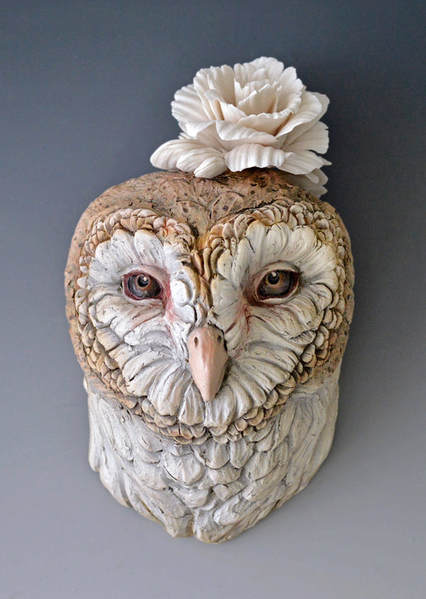
Malia Landis & Wesley T. Wright:
NATURAL PARADOX
island offerings and animal guides
February 2 - March 24, 2018
Open on First Friday, March 2nd, 6-9 pm
Meet the artists and enjoy the refreshments!
Check out the galleries nearby!
(free and open to the public)
Special Event: Artists' Walk-Through
March 17th, 1-3 pm
Enjoy the refreshments as Malia Landis & Wesley T. Wright
walk us through the gallery discussing their
solo and collaborative works in this informal artists' talk!
(free and open to the public)
Malia Landis and Wesley T. Wright’s recent solo and collaborative ceramic works explore flora, fauna
and the natural and not-so-natural order of things.
and the natural and not-so-natural order of things.
Malia Landis and Wesley T. Wright’s ceramic and mixed media works explore the paradox of our desire to participate in and experience the natural world even though the natural world we think we long for doesn’t really exist. Having intervened in the natural order for thousands of years, affecting flora and fauna in so many ways, consciously or not, we don't necessarily know what is natural at all. The work is, to some degree, a response to the distress produced by environmental change and that yearning for a connection to nature that is rapidly disappearing. Nature, however, finds new ways to evolve and transform.
Born on the California coast and growing up as a transplant in Hawaii, Malia Landis is attuned to the sense of beauty and wonder of the plants and wildlife native to both coasts, or perhaps not that native after all. Invasive species crowd out the native over time, brought from one place to another by human intercession. Landis’ exquisite porcelain and mixed media works invite a close look at the delicate birds, flowers and shells that coexist in this ever changing and not so very natural world. The fine detail of these island offerings implies a delicacy and tenuousness to their existence, while at the same time the porcelain and other materials have a surprising strength and longevity.
Wesley T. Wright’s bold ceramic and mixed media works employ powerful symbols of the animal kingdom, jarring a consciousness of the ongoing struggle between man and nature, given that man is also a force of nature. Revered for centuries as guardians and guides, coyotes, wolves, owls and other totem animals here serve to point the way toward potential futures. Wright researches the myth and meanings associated with his subject matter and then responds intuitively and with a sense of humor as the pieces emerge. Beneath their obvious characterizations, these animals hold many layered meanings as stand-ins for ourselves, and our current social experiences. In viewing them we can consider the adaptations that may be required for us to evolve and survive, or our failure to address the consequences of our influence.
While serious about subject matter and technique, Landis and Wright share a whimsicality and sense of humor quite evident in their collaborative works, also on view. Light hearted and playful, the work leaves plenty of room for hope and joy in the paradox of nature.
Born on the California coast and growing up as a transplant in Hawaii, Malia Landis is attuned to the sense of beauty and wonder of the plants and wildlife native to both coasts, or perhaps not that native after all. Invasive species crowd out the native over time, brought from one place to another by human intercession. Landis’ exquisite porcelain and mixed media works invite a close look at the delicate birds, flowers and shells that coexist in this ever changing and not so very natural world. The fine detail of these island offerings implies a delicacy and tenuousness to their existence, while at the same time the porcelain and other materials have a surprising strength and longevity.
Wesley T. Wright’s bold ceramic and mixed media works employ powerful symbols of the animal kingdom, jarring a consciousness of the ongoing struggle between man and nature, given that man is also a force of nature. Revered for centuries as guardians and guides, coyotes, wolves, owls and other totem animals here serve to point the way toward potential futures. Wright researches the myth and meanings associated with his subject matter and then responds intuitively and with a sense of humor as the pieces emerge. Beneath their obvious characterizations, these animals hold many layered meanings as stand-ins for ourselves, and our current social experiences. In viewing them we can consider the adaptations that may be required for us to evolve and survive, or our failure to address the consequences of our influence.
While serious about subject matter and technique, Landis and Wright share a whimsicality and sense of humor quite evident in their collaborative works, also on view. Light hearted and playful, the work leaves plenty of room for hope and joy in the paradox of nature.
